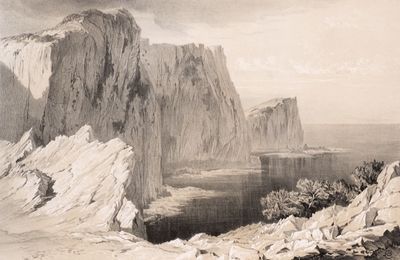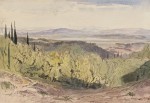Edward Lear in Corfu
by Adrian Tahourdin
Edward Lear loved Corfu. He visited the island no fewer than nine times
and spent more than three years there. He wrote in his diary, in
1866, “Can I give no idea of this Paradise island to others?”
To mark Lear’s bicentenary this year, the Corfu Museum of Asian Art
recently mounted an exhibition entitled “Edward Lear & the Ionian Islands”.
The museum, housed in the sumptuous palace of St Michael and St George in Corfu
Town, is the home to a fascinating permanent collection of 10,000 items,
amassed by the Corfiot diplomat Grigorios Manos, and which he donated to the
Greek government in 1926.
Lear was the 20th of 21 children and was handed by his exhausted mother
at the age of 4 to be cared for by his 26-year-old sister Ann, who also
oversaw the education of the sickly child: he suffered from epilepsy,
depression and asthma and was later advised to travel to the Mediterranean for
his health.
The artist went to Rome in the 1830s and first travelled to Greece in
1848, on a “sketching tour”. He would later venture to the Middle East and on
to India and Ceylon. He also travelled in Albania, whose mountains rise
up across the Corfu Straits, a mere 3km across at some points, and
visited the ancient city of Butrint, now a Unesco World Heritage Site.
The Ionian Islands were a British Protectorate until 1864, when they
were handed over to Greece. Corfu had a thriving British community which
appears to have been something of a trial for Lear, although he did form a
close attachment with Frank Lushington, who was ten years younger than him and
had been appointed judge at the Supreme Court of the Ionian Islands. In the
view of Lear’s biographer Susan Chitty, his love for a succession of younger
men was probably platonic.
Writing in the excellent catalogue accompanying the exhibition (with
facing text in Greek), Anthony Stevens, of the Royal College of Psychiatrists
and a member of the International Association for Analytical Psychology (who
also lives in retirement on Corfu), provides an interesting analysis of the
artist, and discusses his repressed homosexuality. Stevens speculates that the
six weeks that Lear and Lushington spent travelling in the Peloponnese "were probably the
happiest six weeks of Lear's life".
The works in the exhibition - watercolours, pencil pen and watercolour,
oils, and lithographs - are all of outdoor scenes, some of an unerring
precision. Not for nothing did he refer to himself as the “Painter of Poetical
Topography”.
According to Christopher Baker, Deputy Director of the Scottish National
Gallery and the author of another excellent essay in the catalogue, in which he
discusses the role of the artist in 19th-century Britain, the album of 20
prints he would produce, "Views in the Seven Ionian Islands", was
“one of the most attractive illustrated travel books of the second half of the
19th century” (the artist “wrote 600 letters to potential subscribers in order
to ensure the success of the enterprise”).
Lear would often inscribe his drawings and watercolours, in a clear
hand, recording the precise time it had been composed, and giving himself tips
as an aid for completion. These charming inscriptions remain on some works:
“Cushions of wild Artichokes or Acanthus”; “But the wild Asphodel flowers are
nearly all gone”; “innumerable olives”; “wait abit”; “grey rox”; “very red”. On
a sketch of a scene in Cephalonia he writes “The whole - and all the scenery -
is immensely gloomy and grand - not to say forbidding”.
Of a scene in Corfu Lear wrote, in February 1863, “Absolute glorious
calm & clearness all day . . . the magnificent colour of these dells of
orange & lemon trees, with the greyer olive & amethyst hills, are
inimitable & wondrous”.
According to the art historian Fani-Maria Tsigakou, Lear’s “Greek
production is a unique treasure trove of visual testimonies for anyone
interested in tracing Greece’s authentic natural environment in the 19th
century. It is also equally valuable to those attempting to recreate the image of the Greek landscape before the damaging effects of modern-day
distortions and widespread development”. She calls him “the Painter par
excellence of the 19th-century Greek Landscape”.
He himself knew the value of what he was doing. As he wrote in 1856,
“Strange that what to me is always painful & disagreeable work - painting -
should in a couple of months create a work which not only gives pleasure to its
possessor at present but may continue to do so to hundreds of others for a
century or more”.
By a strange coincidence Lear shares his (bi)centenary with another
great celebrator of Corfu: I'm thinking of course of Lawrence Durrell, whose
"Prospero's Cell" remains one of the finest books written about the
island.
Peter Stothard's Blog
- Peter Stothard's profile
- 30 followers





